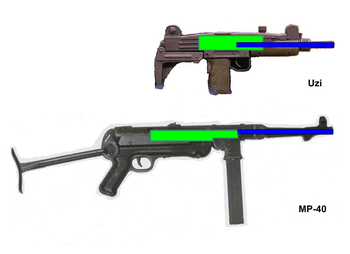Telescoping bolt

A telescoping bolt (also known as an overhung bolt) is a firearm
While it would be simpler and easier to shorten the bolt to fit completely behind the breech, the bolt must have a certain amount of mass in order to operate reliably with a given caliber. The telescoping bolt moves some of that mass forward of the bolt face, resulting in a bolt which may be longer overall, but is shorter behind the bolt face.
Though technically a different, distinct concept, nearly all telescoping bolt submachine guns use a magazine located in the pistol grip used to hold and fire the weapon. However, there are blowback firearms with the magazine located in the grip that do not use a telescoping bolt, such as Kel-Tec SUB-2000.
History
The telescoping bolt concept first appeared on
The first production model submachine gun using the telescoping bolt concept was the Czechoslovak
The first popularly well-known example was the
The telescoping bolt has subsequently been used in a wide variety of submachine gun designs.
Comparisons
As the image diagrams demonstrate, the basic concept of a telescoping bolt with the magazine well in the handgrip produces significantly more compact weapons. These diagrams show the 1938 design (1939 service)
Utilizing nothing more than a configuration change, and the same materials and fabrication technologies, the Uzi is thus 500 grams (1.1 lb) lighter and 160 mm (6 inches) shorter overall, despite having a longer barrel by 9 mm (0.3 inch).
Examples
- Cz 23 series
- Uzi
- Cellini-Dunn SM-9/SM-90
- MGP-15
- MAC-10
- Alpha GPI
- Patria submachine gun
- Steyr MPi 69 and MPi 81
References
- ^ GB 190920277
- ^ https://littlegun.be/arme%20belge/artisans%20identifies%20e%20f/a%20fab%20armes%20reunies%20gb.htm
- ^ Back to the Roots Archived 2006-11-28 at the Wayback Machine, Monty Mendenhall, at [1], accessed Jan 10, 2007
